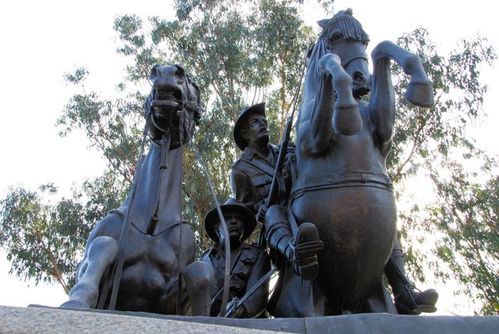
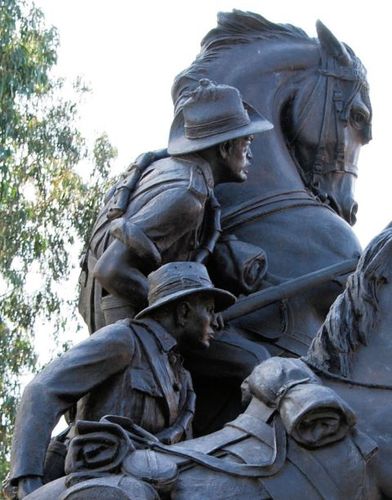
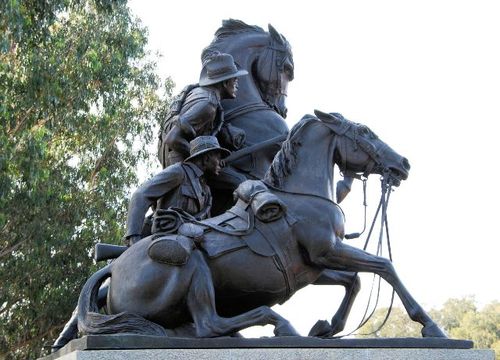
THE DESTRUCTION OF THE ANZAC MEMORIAL
December 26th, 1956
Brief History:
The memorial destined to become the “ANZAC Memorial” was first mooted by the surviving soldiers in Egypt, November 1916. the first reference in print was in The Kia Ora Coo-ee, the Official agazine of the Australian and New Zealand Forces in Egupt
CAIRO May 15th 1918
“representative of the Australian and New Zesland Forcesthen operating
in Sinai met at Mazar and decided that a monument should be erected. Members
of the Australian Light Horsemen (ALH) and New Zealand Mounted Riflemen (NZMR)
responded eagerly when asked to contribute one day’s pay towards the cost
of the Memorial, which, it was proposed, should take the form of an Anzac horseman
in bronze, standing on a base of trachite, whereon would be panels inscribed
with the names of the fallen”
Light horsemen from Australia, New Zealand Mounted Riflemen, the Cameleers and Army Nurses raised £5,400 by subscribing a day’s pay towards the cost. The Commonwealth Government provided another £11,600 and The New Zealand Government a further share. A prize of 250 guineas was offered Commonwealth wide for a design showing two horses and two ANZAC soldiers representing the mounted troops. In 1923 the final design for the memorial was won by an Australian sculptor, C. Webb Gilbert.
In New Zealand the concept of contributing to the ANZAC Memorial was met with a positive response and entering into the expanded design concept of two horsemen resprenting both nations, the NZ Army sent many detailed photographs of both, blinded Gallipoli veteran, trooper Clutha Mackenzie NZMR, and the horse “Bess”. These photographs were taken at Trentham Military Camp and sent to the sculptor to use as models.
Sculpting began on the monument but unfortunately Gilbert died before it was finished, a report at the time saying “the execution of a colossal task far beyond his experience and physical powers broke Gilbert’s heart”. Paul Montford, a leading British sculptor, was chosen to carry on the work. He worked steadily but the memorial did not seem to show the results of his efforts. The task was passed on to another Australan sculptor, Sir Bertram Mackennal who, with a team of British assistants completed the monument but he too died before he had the honour of seeing it unveiled.
On 23rd November 1932 it was unveiled on behalf of the Australian and New Zealand Governments by Australia’s war time Prime Minister, W.M. Hughes who was on his way back from a League of Nations meeting in Europe, The proceedings were broadcast by radio telephone over the 15,000 miles between Egypt and Australia, the first such direct broadcast between those two countries.
 |
 |
 |
The Riots of the 26th December 1956
On the night of 26th December 1956, during the Suez Crisis, rioters having successfully blown the statue of de Lessops from his position overlooking the Suez Canal turned their attention to the nearby ANZAC monument. An Egyptian crowd attacked the ANZAC monument, smashing it with hammers and large stones. The Egyptian newspaper, Al Akhbar, reported that "the memorial would be blown up with dynamite". Police were posted beside the memorial to protect it and forbade the use of explosives but took no steps to prevent youths defacing it. It was pulled from its base and smashed beyond repair.
The mob tore of the legs and tail of the New Zealander’s horse, smashed away the legs, tail and half the head of the Australian’s horse and sawed off the head, arms and legs of the New Zealander. The figure of the Australian light horseman disappeared.
When peace returned to the area the United Arab Republic agreed to the request of the Australian and New Zealand Governments to release the damaged memorial and its polished Gabo Island granite plinth which were shipped to Australia.
After the destructions of the ANZAC Memorial in Egypt in 1956 the Australian and New Zealand Governments decided to build a replacement monument and site it in Australia, and in 1964 the reproduction was completed and erected in Albany, Western Australia.
Some years after its reconstruction the Albany memorial began to show signs
of weathering and corrosion. The stonework became stained by algae, the bronze
statue was pitted and water entered the inside of the monument causing more
damage. In February 1977, a $1000 grant from the Commonwealth Government was
used to have the stonework chemically cleaned and damage to the bronze repaired
to prevent the entry of water.
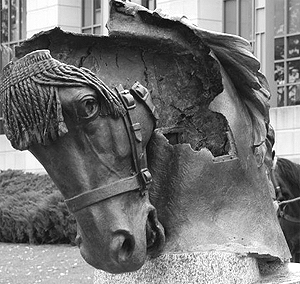 |
 |
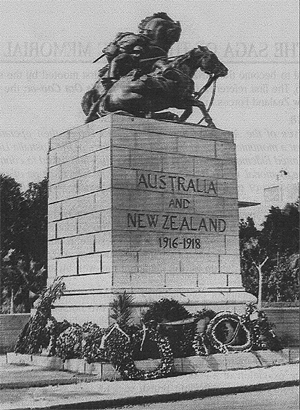 |